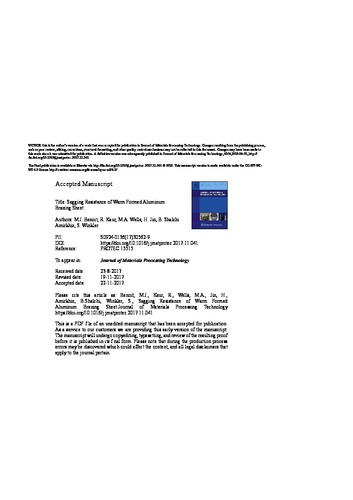| dc.contributor.author | Benoit, Michael J. | |
| dc.contributor.author | Kaur, R. | |
| dc.contributor.author | Wells, Mary | |
| dc.contributor.author | Jin, H. | |
| dc.contributor.author | Amirkhiz, B. Shalchi | |
| dc.contributor.author | Winkler, Sooky | |
| dc.date.accessioned | 2018-01-12 16:35:52 (GMT) | |
| dc.date.available | 2018-01-12 16:35:52 (GMT) | |
| dc.date.issued | 2018-04-01 | |
| dc.identifier.uri | https://doi.org/10.1016/j.jmatprotec.2017.11.041 | |
| dc.identifier.uri | http://hdl.handle.net/10012/12849 | |
| dc.description | NOTICE: this is the author’s version of a work that was accepted for publication in Journal of Materials Processing Technology. Changes resulting from the publishing process, such as peer review, editing, corrections, structural formatting, and other quality control mechanisms may not be reflected in this document. Changes may have been made to this work since it was submitted for publication. A definitive version was subsequently published in Journal of Materials Processing Technology, #254,2018-04-01, http://dx.doi.org/10.1016/j.jmatprotec.2017.11.041
The final publication is available at Elsevier via http://dx.doi.org/10.1016/j.jmatprotec.2017.11.041 © 2018. This manuscript version is made available under the CC-BY-NC-ND 4.0 license http://creativecommons.org/licenses/by-nc-nd/4.0/ | en |
| dc.description.abstract | Interrupted tensile tests, performed between room temperature (RT) and 250°C, were used to simulate warm forming of an AA3003/AA4045 brazing sheet. Brazing performance was predicted from sagging distance measurements after a thermal cycle. The sagging distance as a function of strain for sheets strained at 150°C was similar to that of RT strained samples, while the sagging distances were larger at all levels of applied strain for sheets strained at 200°C and 250°C. Large sagging distances were correlated with the occurrence of liquid film migration during simulated brazing and a recovered substructure in the core alloy, while small sagging distances were associated with a coarse, recrystallized core alloy. The poor brazing performance of sheets formed above 150°C was attributed to a reduction in the stored strain energy during forming, resulting in recovery rather than recrystallization during brazing, leaving a microstructure which is susceptible to liquid film migration. | en |
| dc.description.sponsorship | Natural Sciences and Engineering Research Council of Canada [Grant number APCPJ 447970-13]
Ontario Research Fund and Initiative for Automotive Manufacturing Innovation [File number RE-1-054] | en |
| dc.language.iso | en | en |
| dc.publisher | Elsevier | en |
| dc.rights | Attribution-NonCommercial-NoDerivatives 4.0 International | * |
| dc.rights.uri | http://creativecommons.org/licenses/by-nc-nd/4.0/ | * |
| dc.subject | Brazing | en |
| dc.subject | Liquid film migration (LFM) | en |
| dc.subject | Recrystallization | en |
| dc.subject | Sagging distance | en |
| dc.subject | Strain induced boundary migration (SIBM) | en |
| dc.subject | Warm forming | en |
| dc.title | Sagging resistance of warm formed aluminum brazing sheet | en |
| dc.type | Article | en |
| dcterms.bibliographicCitation | Benoit, M. J., Kaur, R., Wells, M. A., Jin, H., Amirkhiz, B. S., & Winkler, S. (2018). Sagging resistance of warm formed aluminum brazing sheet. Journal of Materials Processing Technology, 254, 353–360. https://doi.org/10.1016/j.jmatprotec.2017.11.041 | en |
| uws.contributor.affiliation1 | Faculty of Engineering | en |
| uws.contributor.affiliation2 | Mechanical and Mechatronics Engineering | en |
| uws.typeOfResource | Text | en |
| uws.peerReviewStatus | Reviewed | en |
| uws.scholarLevel | Faculty | en |
| uws.scholarLevel | Graduate | en |


